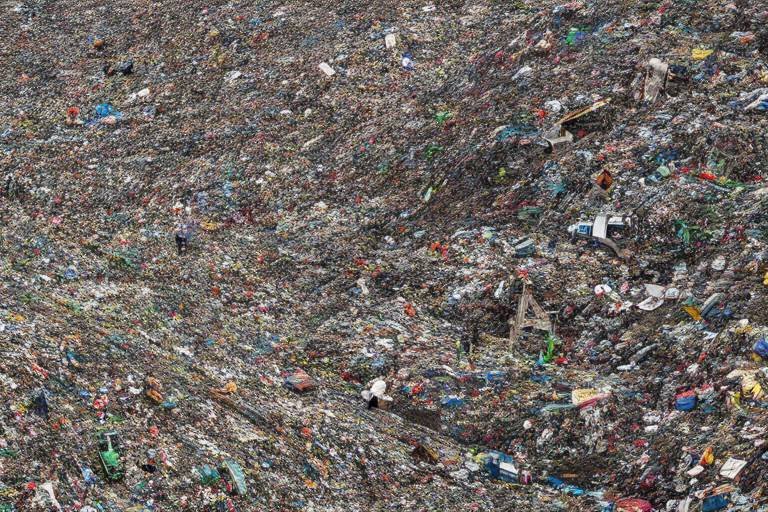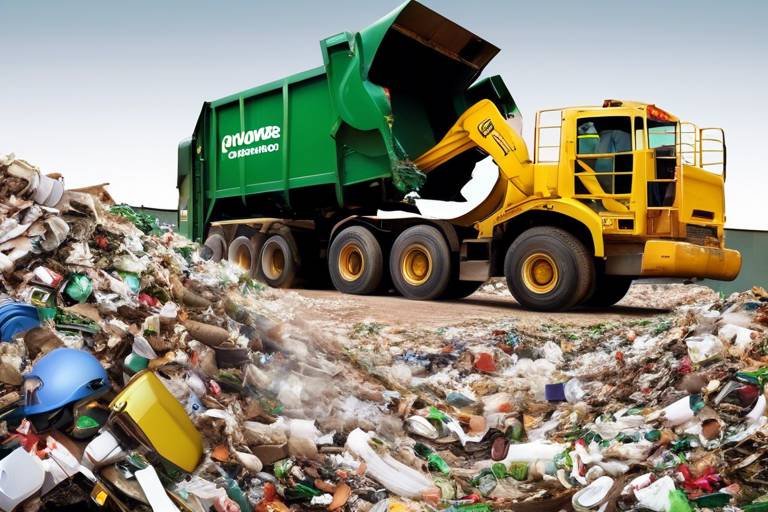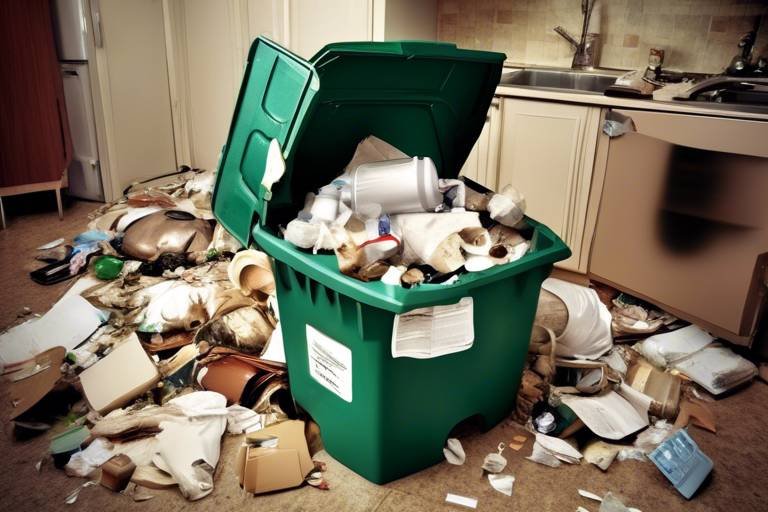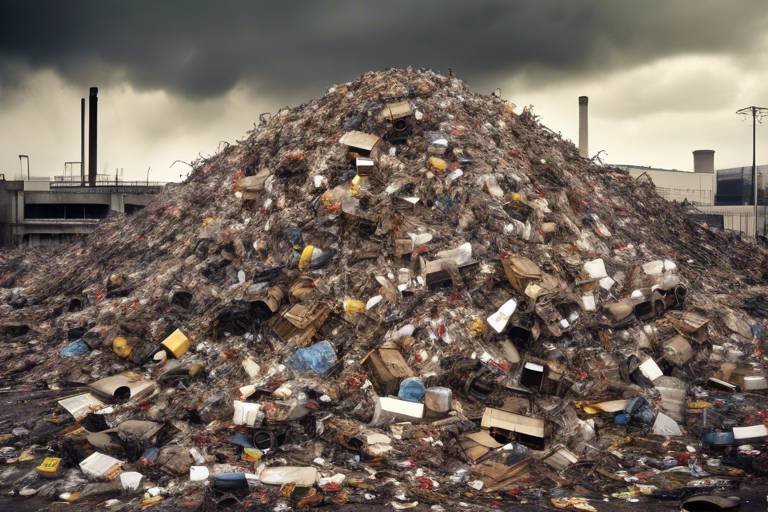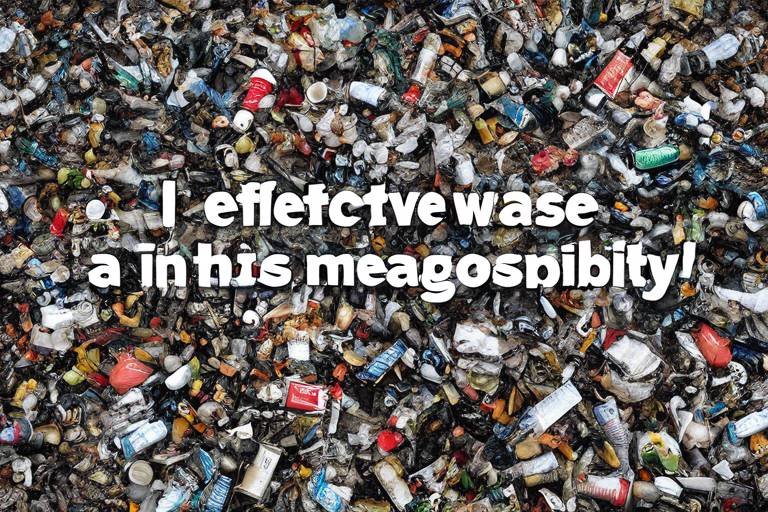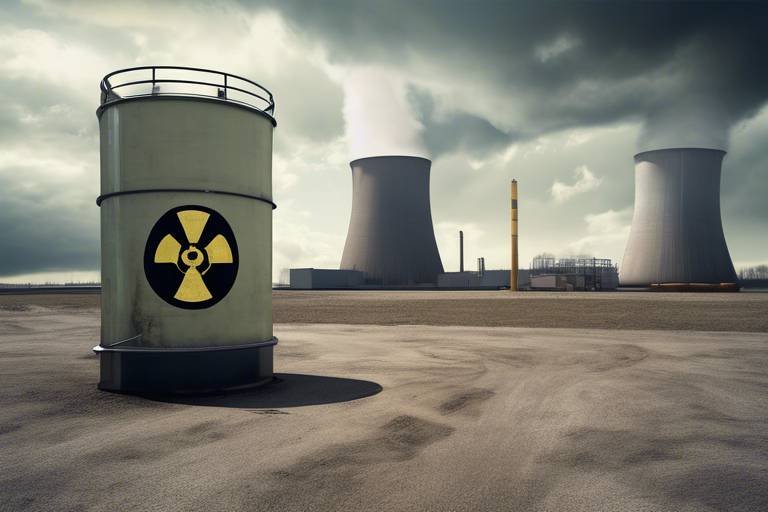How Does a Landfill Work?
Have you ever wondered what happens to your trash after it leaves your home? The journey of waste is often shrouded in mystery, but understanding how a landfill works can shed light on this crucial aspect of waste management. A landfill is not just a big hole in the ground where we dump our garbage; it's a carefully designed system that aims to contain waste safely while minimizing its impact on the environment. In this article, we'll explore the intricate workings of landfills, from their anatomy to the processes that occur within them, and why this knowledge is vital for sustainable waste management.
At its core, a landfill is a complex structure that consists of multiple layers, each serving a specific purpose. The design of a landfill is crucial for ensuring that waste is contained and that harmful substances do not leach into the surrounding soil and groundwater. Key components of a landfill include:
- Liners: These are impermeable barriers, often made of clay or synthetic materials, that prevent leachate—liquid that drains or 'leaches' from the waste—from escaping into the environment.
- Leachate Collection Systems: These systems capture any leachate that does form, allowing for proper treatment and disposal.
- Gas Management Systems: As waste decomposes, it produces gases like methane and carbon dioxide. Effective gas management systems capture these gases to reduce odors and prevent greenhouse gas emissions.
Understanding these components is essential because they play a significant role in how landfills operate. For instance, the liners are the first line of defense against environmental contamination, while the leachate collection systems ensure that any potentially harmful liquids are safely managed. Together, these systems work to create a controlled environment where waste can decompose over time.
But how does waste actually break down in a landfill? The decomposition process is fascinating and involves a combination of biological, chemical, and physical factors. Over time, organic materials in the waste, such as food scraps and yard waste, begin to break down. This process can be influenced by various factors, including moisture levels, temperature, and the presence of oxygen. The two primary types of decomposition that occur in landfills are aerobic and anaerobic, each with its own characteristics and implications for waste management.
In aerobic decomposition, microorganisms break down organic waste in the presence of oxygen. This process tends to be faster and results in fewer odors, making it an ideal scenario for waste management. On the other hand, anaerobic decomposition occurs in the absence of oxygen, leading to the production of methane—a potent greenhouse gas. This is where the challenges of landfill management come into play, as controlling methane emissions is crucial for minimizing environmental impact.
When comparing aerobic and anaerobic decomposition, it's essential to understand their distinct characteristics. Aerobic decomposition generally leads to:
- Faster breakdown of organic material
- Reduced odors and unpleasant smells
- Lower greenhouse gas emissions
On the flip side, anaerobic decomposition presents challenges, primarily due to the methane produced. This gas can escape into the atmosphere if not properly captured, contributing to climate change. Therefore, managing the decomposition process effectively is vital for landfill operations.
As waste decomposes, landfills produce gas, primarily consisting of methane and carbon dioxide. Capturing this landfill gas is crucial, not just for environmental protection but also for harnessing it as a renewable energy source. Many modern landfills have systems in place to collect this gas, which can then be used to generate electricity or heat, turning waste into a valuable resource.
Landfills are subject to strict regulations designed to protect public health and the environment. These regulations dictate everything from how waste is managed to how leachate and gas are handled. Compliance with these standards is essential for maintaining the integrity of landfill operations and ensuring that they do not pose a risk to surrounding communities.
Regular monitoring is key to ensuring that landfills adhere to environmental standards. This involves checking for leachate levels, gas emissions, and other factors that could indicate potential problems. By staying vigilant and compliant, landfill operators can mitigate risks and protect both public health and the environment.
As we move towards a more sustainable future, landfill management is evolving. New technologies and strategies aim to improve efficiency and reduce environmental impact. For instance, advancements in waste sorting and recycling technologies can divert more materials away from landfills, while innovations in gas capture can enhance renewable energy production.
1. What types of waste can be disposed of in a landfill?
Landfills typically accept household waste, construction debris, and certain industrial wastes. However, hazardous materials like batteries and chemicals must be disposed of separately.
2. How long does waste take to decompose in a landfill?
The decomposition time varies significantly depending on the type of waste. Organic materials may take a few months to a couple of years, while plastics can take hundreds of years to break down.
3. Can landfills be converted into useful spaces after closure?
Yes! Many closed landfills are transformed into parks, recreational areas, or solar farms, demonstrating that waste management can contribute positively to community spaces.

The Anatomy of a Landfill
Understanding the anatomy of a landfill is essential for grasping how waste is managed and contained. A landfill is not just a vast hole in the ground where garbage is dumped; it is a meticulously designed structure that consists of several layers, each serving a specific purpose to ensure safety and environmental protection. The primary components of a landfill include:
- Liners: These are impermeable barriers made from materials like clay or synthetic membranes. They are crucial for preventing leachate, which is the liquid that forms when waste breaks down, from contaminating the surrounding soil and groundwater.
- Leachate Collection Systems: This system collects and transports leachate away from the landfill. It typically consists of pipes and drains that direct the leachate to a treatment facility, ensuring that any harmful substances are properly managed.
- Gas Management Systems: As waste decomposes, it generates gases, primarily methane and carbon dioxide. The gas management system captures these gases to prevent them from escaping into the atmosphere, where they could contribute to climate change. Captured gases can also be harnessed as a renewable energy source.
These layers work together to create a safe environment for waste disposal. The liner acts as the first line of defense, preventing contaminants from leaching into the ground. The leachate collection system ensures that any liquid that does form is safely removed and treated, while the gas management system captures harmful gases, turning a potential environmental hazard into a source of energy.
Additionally, a well-designed landfill includes a cover system that protects the waste from the elements and helps control odors. This cover can be made of soil, vegetation, or synthetic materials, and it plays a crucial role in minimizing the impact of the landfill on the surrounding environment.
Furthermore, the design of a landfill is not static; it evolves based on technological advancements and regulatory requirements. Modern landfills incorporate features such as stormwater management systems to prevent rainwater from mixing with waste, which could lead to increased leachate production. These systems help manage runoff and reduce the overall environmental impact of the landfill.
In summary, the anatomy of a landfill is a complex interplay of various components designed to manage waste safely and efficiently. Understanding these components is vital for recognizing the importance of proper landfill management in protecting our environment.
Q1: What is the primary purpose of a landfill?
A landfill's primary purpose is to safely contain and manage waste materials while minimizing environmental impact.
Q2: How do landfills prevent contamination of groundwater?
Landfills use liners and leachate collection systems to prevent contaminants from escaping into the groundwater.
Q3: What happens to the gases produced in a landfill?
The gases produced during waste decomposition are captured by gas management systems and can be used as a renewable energy source.

The Waste Decomposition Process
When we toss our trash into a landfill, it might seem like it just sits there, but the reality is much more dynamic and fascinating. The waste decomposition process is a complex interplay of biological, chemical, and physical factors that transform our discarded materials into new forms. Understanding this process is crucial, not just for waste management, but for our overall environmental health. So, how does this transformation happen?
At the core of waste decomposition are microorganisms, which play a pivotal role in breaking down organic materials. These tiny organisms, including bacteria and fungi, feast on the waste we produce, breaking it down into simpler substances. This process is influenced by several factors, such as temperature, moisture, and the type of waste itself. For instance, organic materials like food scraps decompose much faster than inorganic materials like plastics. The decomposition process can generally be divided into two main categories: aerobic and anaerobic decomposition, each with its unique characteristics and outcomes.
Aerobic decomposition occurs in the presence of oxygen, while anaerobic decomposition takes place in environments devoid of oxygen. This distinction is vital because it affects how waste breaks down and the byproducts produced. In aerobic environments, microorganisms thrive and break down waste efficiently, producing carbon dioxide and water as byproducts. This process is not only faster but also less odorous, making it more desirable for landfill management.
On the other hand, anaerobic decomposition, which occurs in the absence of oxygen, is slower and often produces methane—a potent greenhouse gas that contributes to climate change. The challenges associated with anaerobic decomposition are significant, as managing methane emissions is critical for environmental protection. Landfill operators must implement strategies to capture and utilize this gas, turning a potential hazard into a renewable energy source.
Encouraging aerobic decomposition can lead to numerous benefits in landfill operations. By promoting conditions that favor oxygen-rich environments, landfill managers can:
- Reduce odors associated with waste breakdown.
- Speed up the decomposition process, allowing for more efficient waste management.
- Minimize the production of methane, thus lessening environmental impact.
One effective way to enhance aerobic decomposition is through the introduction of air into the waste layers, a method known as aeration. This can be achieved through various techniques, such as using perforated pipes to inject air into the waste or turning the waste to mix it with oxygen. Ultimately, the goal is to create a thriving ecosystem of microorganisms that can efficiently break down waste.
While anaerobic decomposition is a natural process, it presents several challenges. The primary concern is the generation of methane, a greenhouse gas that is significantly more effective at trapping heat in the atmosphere than carbon dioxide. This poses a severe environmental risk, as uncontrolled methane emissions can contribute to global warming.
To address these challenges, landfill operators must implement effective gas management systems that capture methane and convert it into energy. This not only mitigates environmental impact but also provides a renewable energy source that can be harnessed for electricity or heating. By investing in technology and infrastructure, we can turn a potential problem into a sustainable solution.
In summary, the waste decomposition process is a vital aspect of landfill management. By understanding the differences between aerobic and anaerobic decomposition, we can develop strategies to enhance waste breakdown, reduce odors, and minimize harmful emissions. As we continue to learn more about these processes, we can make informed decisions that benefit both our communities and the environment.
- What is the primary difference between aerobic and anaerobic decomposition?
Aerobic decomposition occurs with oxygen present and is faster and less odorous, while anaerobic decomposition occurs without oxygen and produces methane. - How can we encourage aerobic decomposition in landfills?
By enhancing airflow through aeration techniques, landfill operators can create conditions favorable for aerobic microorganisms. - What are the environmental impacts of methane emissions from landfills?
Methane is a potent greenhouse gas that contributes significantly to climate change, making its management crucial for environmental protection.

Aerobic vs. Anaerobic Decomposition
When we think about how waste breaks down in a landfill, two main processes come to mind: aerobic and anaerobic decomposition. These processes are like two sides of the same coin, each playing a crucial role in the lifecycle of waste. But what exactly sets them apart? Let’s dive into the nitty-gritty!
Aerobic decomposition occurs in the presence of oxygen. Imagine a bustling city where everyone is out and about, enjoying the sunshine. In this vibrant environment, organic materials like food scraps and yard waste break down quickly, thanks to the action of oxygen-loving microorganisms. These microorganisms, such as bacteria and fungi, work tirelessly to convert waste into simpler substances, ultimately producing carbon dioxide, water, and nutrients that can enrich the soil. This process is generally faster and produces less odor, making it a more pleasant option for waste management.
On the flip side, we have anaerobic decomposition, which takes place in environments devoid of oxygen. Picture a dark, damp cave where the air is stale and stagnant. Here, the same organic materials break down at a much slower pace. Anaerobic bacteria step in, but their process is quite different. Instead of producing carbon dioxide, these bacteria generate methane—a potent greenhouse gas that can have serious environmental repercussions. While this decomposition method can be beneficial for capturing gas for energy, it poses significant challenges in terms of managing emissions and odors.
To put it simply, here’s a quick comparison:
| Feature | Aerobic Decomposition | Anaerobic Decomposition |
|---|---|---|
| Oxygen Requirement | Requires oxygen | No oxygen present |
| Speed of Decomposition | Faster | Slower |
| Byproducts | Carbon dioxide and nutrients | Methane and other gases |
| Odor | Less odor | Strong odor |
Understanding these two processes is essential for effective landfill management. By promoting aerobic conditions, landfill operators can significantly enhance waste breakdown, reduce odors, and minimize greenhouse gas emissions. However, in many traditional landfills, anaerobic conditions prevail, leading to the production of methane. This highlights the importance of implementing strategies that encourage aerobic decomposition, such as incorporating air into the waste layers or utilizing specific technologies designed to enhance oxygen levels.
In conclusion, both aerobic and anaerobic decomposition are integral to understanding how landfills function. Each process has its unique characteristics, benefits, and challenges. As we continue to explore innovative waste management solutions, striking a balance between these two methods will be key to achieving a more sustainable future.
- What is the main difference between aerobic and anaerobic decomposition?
Aerobic decomposition requires oxygen and is faster, producing carbon dioxide, while anaerobic decomposition occurs without oxygen and generates methane. - Why is methane considered a problem?
Methane is a potent greenhouse gas that contributes to climate change, making its management crucial in landfill operations. - How can we promote aerobic decomposition in landfills?
By improving air circulation and incorporating oxygen into waste layers, landfill operators can encourage aerobic conditions.

Benefits of Aerobic Decomposition
Aerobic decomposition is a process that occurs when organic waste breaks down in the presence of oxygen. This method of waste breakdown is not just a natural phenomenon; it comes with a multitude of benefits that can significantly enhance landfill management and environmental sustainability. Imagine a bustling community of microorganisms working tirelessly to convert waste into valuable resources, all while reducing the negative impacts on our planet. Here are some key advantages of aerobic decomposition:
Firstly, one of the most notable benefits is the speed at which aerobic decomposition occurs. Because oxygen is readily available, microorganisms can break down organic matter much faster than in anaerobic conditions. This rapid breakdown leads to a more efficient use of landfill space, as waste is reduced in volume more quickly. In fact, studies suggest that aerobic processes can reduce the mass of organic waste by up to 90% in some cases, allowing landfills to operate more efficiently.
Additionally, aerobic decomposition helps in odor control. When waste decomposes anaerobically, it often produces foul-smelling gases, which can lead to significant nuisance complaints from nearby communities. In contrast, aerobic decomposition generates less odorous compounds, resulting in a cleaner and more pleasant environment around the landfill. This can foster better relationships between landfill operators and local residents, as the unpleasant smells that are often associated with waste management are minimized.
Moreover, aerobic decomposition can lead to the production of valuable byproducts. The process not only breaks down waste but also generates compost, a nutrient-rich material that can be used to enrich soil in agricultural and landscaping applications. This not only diverts waste from landfills but also contributes to a circular economy where organic waste is transformed into a resource rather than a burden. The use of compost can enhance soil health, improve water retention, and reduce the need for chemical fertilizers, making it an eco-friendly option for farmers and gardeners alike.
Furthermore, aerobic decomposition can aid in greenhouse gas reduction. By promoting aerobic conditions in landfills, the production of methane—a potent greenhouse gas—is significantly reduced. Methane is a byproduct of anaerobic decomposition and is known to be over 25 times more effective at trapping heat in the atmosphere than carbon dioxide over a 100-year period. By fostering aerobic conditions, landfills can mitigate their contribution to climate change, making them more sustainable in the long run.
In conclusion, the benefits of aerobic decomposition are multifaceted, ranging from faster waste breakdown and odor control to the production of compost and reduction of greenhouse gas emissions. By integrating aerobic processes into landfill management, we can create a more sustainable waste management system that not only addresses the challenges of waste disposal but also contributes positively to our environment. The future of landfills lies in embracing these natural processes, turning waste into a resource rather than a problem.

Challenges of Anaerobic Decomposition
Anaerobic decomposition, while a natural process, presents several challenges that can complicate waste management efforts. One of the most significant issues is the production of methane, a greenhouse gas that is more than 25 times as potent as carbon dioxide over a 100-year period. This means that as organic waste breaks down without oxygen, it releases methane into the atmosphere, contributing to climate change.
Another challenge is the slower rate of decomposition compared to aerobic processes. In a landfill, where oxygen is limited, organic materials can take years, if not decades, to break down fully. This prolonged decomposition time not only occupies valuable landfill space but also complicates the management of waste materials. The longer waste remains in a landfill, the more difficult it becomes to monitor and control the environmental impacts associated with it.
Furthermore, the accumulation of leachate, a toxic liquid formed when waste decomposes, poses a significant threat to groundwater and soil quality. In anaerobic conditions, leachate can become highly concentrated and hazardous, making it essential for landfill operators to implement effective leachate management systems. Failure to do so can result in severe environmental contamination, leading to costly remediation efforts and potential legal liabilities.
To manage these challenges effectively, landfill operators often rely on advanced technologies and practices. For instance, they may employ gas collection systems to capture methane and convert it into energy, reducing greenhouse gas emissions. However, the installation and maintenance of these systems can be expensive and require ongoing monitoring to ensure they are functioning correctly.
In summary, while anaerobic decomposition is a natural part of the waste breakdown process, it brings with it a host of challenges that landfill managers must navigate. From methane emissions to leachate management, addressing these issues is crucial for minimizing the environmental impact of landfills and moving towards more sustainable waste management practices.
- What is anaerobic decomposition?
Anaerobic decomposition is the breakdown of organic material in the absence of oxygen, resulting in the production of methane and other gases.
- Why is methane a concern?
Methane is a potent greenhouse gas that significantly contributes to climate change, making its management crucial in landfill operations.
- How can landfills mitigate the impact of anaerobic decomposition?
Landfills can implement gas collection systems, improve leachate management, and explore alternative waste processing methods to reduce environmental impact.
- What technologies are used to capture landfill gas?
Technologies such as gas extraction wells and flaring systems are commonly used to capture and manage landfill gas.

The Role of Landfill Gas
As waste decomposes in a landfill, it generates a mixture of gases, primarily consisting of methane and carbon dioxide. This phenomenon is a natural byproduct of the decomposition process and plays a significant role in both environmental impact and energy production. Understanding the dynamics of landfill gas is crucial for effective waste management and minimizing environmental harm.
Landfill gas is produced when organic matter breaks down under anaerobic conditions, meaning without sufficient oxygen. This process occurs deep within the landfill, where the waste is compacted and sealed away from the atmosphere. The gas composition can vary depending on the type of waste, the age of the landfill, and the specific conditions within it. Typically, the gas produced is about 50-60% methane, which is a potent greenhouse gas, and approximately 40-50% carbon dioxide. Other trace gases may also be present, including hydrogen sulfide and volatile organic compounds (VOCs).
One of the most significant environmental concerns regarding landfill gas is its potential contribution to climate change. Methane is over 25 times more effective than carbon dioxide at trapping heat in the atmosphere over a 100-year period. This makes its management critical not just for environmental protection but also for public health. To mitigate these risks, many landfills are equipped with gas collection systems designed to capture the gas before it escapes into the atmosphere.
Once captured, landfill gas can be treated and utilized as a renewable energy source. This process involves several steps:
- Collection: Gas is collected through a network of wells and pipes that are strategically placed throughout the landfill.
- Processing: The collected gas is then processed to remove impurities and enhance its quality.
- Utilization: The purified gas can be used to generate electricity, heat, or even be upgraded to natural gas quality for use in vehicles.
This transformation of waste into energy not only reduces the amount of harmful gas released into the atmosphere but also provides a sustainable energy source. For instance, capturing and using landfill gas can lead to the generation of enough electricity to power thousands of homes, showcasing the potential of waste management practices that embrace sustainability.
However, the management of landfill gas is not without its challenges. Regular monitoring is essential to ensure that gas collection systems are functioning effectively. Additionally, landfills must comply with strict environmental regulations governing gas emissions. Failure to manage landfill gas appropriately can lead to explosive hazards, as the accumulation of methane can create dangerous conditions if not properly vented.
In conclusion, landfill gas plays a dual role in waste management. While it poses significant environmental risks, it also offers opportunities for renewable energy generation. By understanding its dynamics and implementing effective management practices, we can turn a potential problem into a sustainable solution, ultimately contributing to a greener and more sustainable future.
What is landfill gas?
Landfill gas is a mixture of gases produced by the decomposition of organic waste in landfills, primarily consisting of methane and carbon dioxide.
How is landfill gas captured?
Landfill gas is captured through a network of wells and pipes that draw the gas from the landfill into a collection system.
Can landfill gas be used as energy?
Yes, captured landfill gas can be processed and used to generate electricity, heat, or upgraded to natural gas quality for various applications.
What are the environmental impacts of landfill gas?
Methane is a potent greenhouse gas that contributes to climate change, making its management critical for environmental protection.

When it comes to managing landfills, environmental regulations play a crucial role in ensuring that waste disposal is conducted safely and responsibly. These regulations are designed to protect public health, safeguard the environment, and promote sustainable waste management practices. In many countries, landfill operations are governed by a complex framework of laws and standards that dictate everything from site selection to waste acceptance criteria, and even post-closure care.
One of the key components of these regulations is the requirement for landfill permits. Before a new landfill can be constructed, operators must obtain a permit that outlines how they will manage waste, monitor environmental impacts, and comply with local and national laws. This permit process often involves extensive environmental impact assessments (EIAs) to evaluate potential risks to nearby communities and ecosystems. Without these permits, landfills cannot operate legally, underscoring the importance of regulatory oversight.
Additionally, landfills are required to adhere to strict design and operational standards. These standards typically include the use of liners to prevent leachate—a toxic liquid formed when waste breaks down—from contaminating groundwater. For example, many landfills must utilize a double-liner system, which consists of two layers of synthetic material to provide an added layer of protection. Moreover, leachate collection systems must be installed to capture and treat any liquid that seeps through the liners, ensuring that it does not pose a threat to the surrounding environment.
Another significant aspect of landfill regulation is the management of landfill gas. As waste decomposes, it generates gases such as methane and carbon dioxide. These gases can contribute to climate change if not properly managed. Regulations often require landfills to implement gas collection systems that capture these emissions for either flaring or conversion to energy. This not only reduces greenhouse gas emissions but also provides a renewable energy source, showcasing how regulations can drive innovation in waste management.
Compliance with these regulations is monitored through regular inspections and reporting requirements. Landfill operators must conduct routine monitoring of air, water, and soil quality to ensure that their operations do not negatively impact the environment. Failure to comply with these standards can result in hefty fines, legal action, or even the closure of the landfill. Thus, adherence to environmental regulations is not just a legal obligation; it is a fundamental aspect of responsible waste management.
In summary, the framework of environmental regulations and standards surrounding landfills is essential for protecting our planet and public health. By ensuring that landfills are designed, operated, and monitored according to strict guidelines, we can mitigate the negative impacts of waste disposal and pave the way for more sustainable practices in the future.
- What are the main regulations governing landfills? Regulations vary by region but typically include requirements for permits, design standards, and environmental monitoring.
- How do landfills manage leachate? Landfills use leachate collection systems and treatment facilities to prevent contamination of groundwater.
- What is landfill gas, and why is it important? Landfill gas is a byproduct of waste decomposition, primarily consisting of methane and carbon dioxide. Proper management is crucial to reduce greenhouse gas emissions.
- What happens if a landfill does not comply with regulations? Non-compliance can lead to fines, legal issues, and potential closure of the landfill.

Monitoring and Compliance
Monitoring and compliance are critical components in the management of landfills, ensuring that these waste disposal sites operate within the stringent environmental regulations designed to protect both public health and the surrounding ecosystem. The process of monitoring involves a variety of methods and technologies that track landfill operations, assessing factors such as leachate levels, gas emissions, and overall site integrity. Compliance, on the other hand, refers to the adherence to the laws and regulations set forth by environmental agencies.
One of the primary goals of monitoring is to identify potential issues before they escalate into serious environmental hazards. For instance, regular checks on leachate collection systems help prevent groundwater contamination, while gas monitoring systems ensure that methane emissions are kept in check. These systems not only safeguard the environment but also enhance the landfill's operational efficiency. If issues are detected, immediate corrective actions can be implemented, minimizing the risk of costly fines and environmental damage.
To effectively monitor landfills, operators often utilize a combination of manual inspections and automated monitoring systems. Manual inspections involve on-site evaluations, where trained personnel assess various parameters and conditions of the landfill. Automated systems, such as sensors and drones, can provide real-time data on landfill conditions, offering a more comprehensive view of operations. This dual approach ensures that all aspects of landfill management are covered.
Compliance with environmental regulations is not just about avoiding penalties; it also reflects a landfill's commitment to sustainability and responsible waste management. Landfill operators are required to submit regular reports to regulatory agencies, detailing their operations and any monitoring results. These reports often include:
- Leachate quality and quantity
- Gas emission levels
- Waste acceptance records
- Operational changes
Failure to comply with these regulations can lead to severe consequences, including fines, legal action, and even the closure of the landfill. Therefore, maintaining compliance is not only a legal obligation but also a crucial aspect of a landfill's operational strategy.
In conclusion, monitoring and compliance are essential for the effective management of landfills. By implementing robust monitoring systems and adhering to regulatory standards, landfill operators can ensure that they minimize their environmental impact while providing safe and efficient waste disposal services. As we look to the future, advancements in technology will continue to enhance monitoring capabilities, making it easier for operators to maintain compliance and protect the environment.
What is the purpose of monitoring landfills?
Monitoring landfills helps ensure that they operate within environmental regulations, preventing contamination and mitigating risks to public health and the environment.
What happens if a landfill fails to comply with regulations?
Failure to comply can result in fines, legal action, and potential closure of the landfill, emphasizing the importance of adherence to environmental standards.
How do landfills monitor gas emissions?
Landfills use a combination of manual inspections and automated monitoring systems to track gas emissions, ensuring that methane and other gases are managed effectively.
What technologies are used in landfill monitoring?
Technologies include sensors, drones, and automated data collection systems that provide real-time information on landfill conditions and operations.

Future of Landfill Management
The future of landfill management is not just about managing waste; it's about transforming the way we think about waste itself. As we move further into the 21st century, the challenges posed by increasing waste generation and environmental concerns are pushing us to innovate and adapt. One of the most exciting developments is the integration of technology into landfill operations. Imagine smart landfills equipped with sensors that monitor waste decomposition in real-time, allowing for more efficient management and reduced environmental impact. This is not science fiction; it's happening now!
Moreover, the concept of circular economy is gaining traction. Instead of viewing waste as a final product, we are learning to see it as a resource. This shift in perspective encourages recycling, composting, and waste-to-energy technologies that can significantly reduce the amount of waste sent to landfills. For instance, advanced recycling technologies can convert plastics back into usable raw materials, thus minimizing landfill dependency.
Another critical aspect of future landfill management is the focus on sustainability. Landfills are increasingly being designed with environmental impact in mind. This includes the use of advanced liners and leachate collection systems that minimize contamination of the surrounding land and water. Additionally, many landfills are now incorporating renewable energy systems, such as capturing landfill gas for electricity generation. This not only helps in reducing greenhouse gas emissions but also provides a sustainable energy source.
Furthermore, community engagement is becoming a vital component of landfill management. As public awareness of environmental issues grows, communities are demanding more transparency and involvement in how local landfills operate. This means that landfill operators are now more accountable than ever, leading to better practices and enhanced public trust. Engaging the community can also foster initiatives like local recycling programs, further reducing the waste that ends up in landfills.
To sum it up, the future of landfill management is bright and full of potential. With the right combination of technology, sustainability practices, and community involvement, we can transform landfills from mere waste disposal sites into valuable resources that contribute to a healthier planet. The journey towards effective landfill management is ongoing, and it requires collaboration among governments, businesses, and individuals to make it a reality.
- What is the main goal of modern landfill management? The main goal is to minimize environmental impact while maximizing resource recovery through recycling and energy generation.
- How does technology improve landfill operations? Technology enhances monitoring, optimizes waste decomposition processes, and facilitates energy recovery from landfill gas.
- What role do communities play in landfill management? Communities are essential for promoting transparency, engaging in local recycling initiatives, and holding landfill operators accountable.
Frequently Asked Questions
- What is a landfill and how does it work?
A landfill is essentially a designated area where waste is disposed of and managed. It works by layering waste in a controlled manner, using various engineering techniques to minimize environmental impact. This includes components like liners to prevent leakage, leachate collection systems to manage liquid waste, and gas management systems to capture harmful gases.
- What happens to waste in a landfill over time?
Over time, waste in a landfill undergoes a decomposition process that can be biological, chemical, or physical. Organic materials break down through these processes, influenced by factors such as moisture, temperature, and the presence of oxygen. This decomposition can take years, depending on the type of waste.
- What is the difference between aerobic and anaerobic decomposition?
Aerobic decomposition occurs in the presence of oxygen and typically results in faster waste breakdown with fewer odors. In contrast, anaerobic decomposition happens without oxygen, producing methane, a potent greenhouse gas. Understanding this difference is crucial for effective landfill management.
- Why is managing landfill gas important?
Landfill gas, primarily composed of methane and carbon dioxide, is generated during waste decomposition. Managing this gas is vital because methane is a powerful greenhouse gas that contributes to climate change. Capturing and utilizing landfill gas can convert it into renewable energy, reducing environmental impact.
- What regulations govern landfill operations?
Landfills are subject to strict environmental regulations that ensure they operate safely and sustainably. These regulations cover aspects such as waste acceptance, monitoring, and compliance with environmental standards. Adhering to these regulations is essential for protecting public health and the environment.
- How are landfills monitored for compliance?
Regular monitoring of landfills involves a variety of methods, including groundwater testing, gas emissions measurements, and visual inspections. This monitoring ensures that landfills remain compliant with environmental standards and helps identify any potential issues before they escalate.
- What is the future of landfill management?
The future of landfill management is evolving with advancements in technology and innovative practices. Emerging trends include improved waste sorting techniques, enhanced gas capture methods, and the promotion of recycling and composting to reduce the amount of waste sent to landfills. These innovations aim to create more sustainable waste management solutions.

